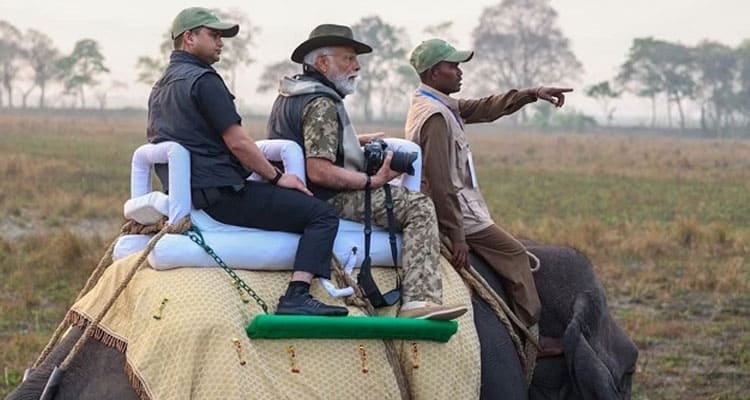PM Modi Visits Kaziranga National Park In Assam –The Home of the One-Horned Rhino Latest, Top state pioneer Narendra Modi visited the Kaziranga Recreational area and Tiger Hold in Assam on Walk 9, 2024.
The recreational area is known for its gigantic standard greatness and different untamed life, including the one-horned rhinoceros, which is the entertainment region’s for the most part prestigious inhabitant. Modi’s visit to Kaziranga was significant for his two-excursion to Assam, during which he started and laid out the foundation of various exercises worth Rs 18,000 crore.
During his visit, Modi took an elephant and jeep safari inside the recreational area, which outfitted him with an opportunity to notice the diversion region’s rich biodiversity extremely close. He shared checks on his “significant” visit using online diversion, which included pictures of him riding an elephant and spotting various animals comfortable out. The Express head’s visit to Kaziranga Recreational area includes the public power’s commitment to defending India’s ordinary heritage and propelling ecotourism in the country.
Kaziranga Recreational area is home to more than 2,200 one-horned rhinoceroses, which is 66% of the complete people of this risky species. The diversion region is in like manner home to other unprecedented and imperiled animals, including tigers, elephants, wild water buffalo, and bog deer. The diversion region’s stand-out organic framework and biodiversity merit it the circumstance with a UNESCO World Heritage Site.
Political Relations and Nearby Development
Top state pioneer Narendra Modi’s visit to Kaziranga Recreational area in Assam holds basic importance concerning political relations and regional development. The visit wanted to show off the public power’s commitment to regular safeguarding and improvement drives.PM Modi Visits Kaziranga National Park In Assam The Express head’s visit to the UNESCO World Heritage Site starting around 1957 is a tremendous step towards highlighting the meaning of regular life insurance and conservative new development.
The visit moreover wanted to support ties between the central government and the northeastern states, particularly Assam. The Express chief’s visit to the locale should help the movement business and advance the rich social tradition of the state. The visit is furthermore expected to stimulate monetary turn of events and improvement nearby.
Conservation Tries for One-Horned Rhinos
Kaziranga Recreational area is home to the outstanding Inconceivable Indian one-horned rhinoceros, and the visit is expected to highlight the conservation tries being made to shield this risked species. The diversion region boasts a scene of thick forest areas, rising above elephant grass, intense reeds, and shallow bogs, giving a characteristic environmental factors to an alternate extent of untamed life.
During his visit, Top state pioneer Modi took the elephant and jeep safari inside the diversion region and dealt with the elephants. He in like manner perceived a one-horned rhino, which is a phenomenal sight. The visit is expected to cause to see the protection attempts being made to defend the one-horned rhino and other endangered species in the diversion region.
With everything taken into account, Top state pioneer Modi’s visit to Kaziranga Recreational area holds enormous importance regarding optional relations, nearby new development, and normal life security. The visit intended to show the public power’s commitment to normal protection and improvement drives while highlighting the meaning of defending risked species like the one-horned rhino.
Kaziranga Recreational area: A Biodiversity Area of interest
Kaziranga Recreational Area is a UNESCO World Heritage site located in the Indian territory of Assam. It is known in general for its pivotal normal life and is home to the greatest people of one-horned rhinoceroses on the planet. The amusement region covers an area of 430 square kilometers and is organized on the banks of the Brahmaputra Stream.
Vegetation Assortment
The diversion region is a biodiversity area of interest and is home to a collection of vegetation. The diversion region has an amount of 35 sorts of very much developed animals, including the Indian elephant, Bengal tiger, and wild water buffalo. It is in like manner home to more than 450 sorts of birds, including the risked Bengal florican, and different reptiles and animals of land and water.
The entertainment region’s vegetation is overpowered by tall elephant grass, which gives an ideal living space to the diversion region’s herbivores. The diversion region moreover has different trees, hedges, and land and water-proficient plants.
The Movement Business and Economy
Kaziranga Recreational area is a huge voyager goal and attracts visitors from wherever the world. The diversion region offers various activities, including elephant and jeep safaris, bird watching, and stream voyages. The diversion region moreover has a couple of eco-the-movement business lodgings and resorts that offer pleasing comfort to visitors.
The movement business is a critical source of income for the close by economy, and the diversion region gives work significant entryways to the local people. The entertainment region furthermore expects a critical part in the protection and helps with shielding the endangered species that call it home.
All things considered,PM Modi Visits Kaziranga National Park In Assam the Kaziranga Recreational area is a biodiversity area of interest and a huge explorer objective in India. It is home to a combination of vegetation and gives businesses possible entryways to the local people. The diversion region plays a huge part in conservation and helps with defending the imperiled species that call it home.
Also Read: Indians Can Now Pay with UPI in Nepal: A Landmark Achievement for Digital Payments Latest




